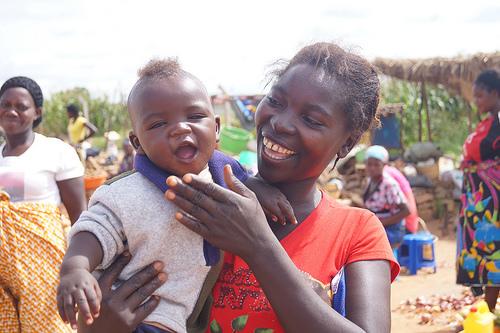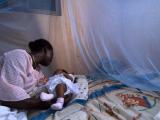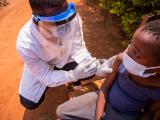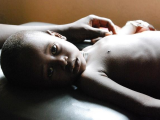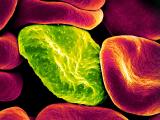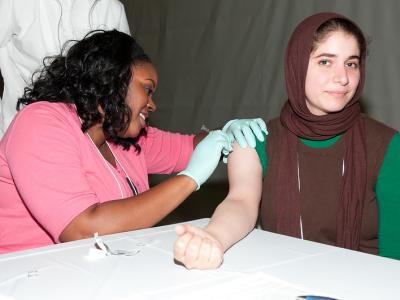Although Zika virus infections have drawn the recent spotlight, malaria—another mosquito-borne disease that affects and kills a far greater number of people—can also pose special problems for pregnant women and their babies.
Two studies in the New England Journal of Medicine last week support the use of artemisinin-based combination therapy to both prevent and treat Plasmodium falciparum malaria in pregnant, sub-Saharan women, filling a void on safety and efficacy data in this population. And the smaller of the two studies determined that a new combination drug outperformed the standard treatment recommended by the World Health Organization (WHO).
The WHO says that about 214 million malaria cases occurred in 2015, including 438,000 deaths. And the WHO estimates that 88% of all malaria cases and 90% of malaria-induced deaths in 2015 occurred in sub-Saharan Africa. Pregnant woman are especially susceptible to the disease because of reduced immunity, and in some settings, they have a greater risk of severe disease.
Birth defects are also a risk; in an editorial introducing the two studies, Joel Tarning, PhD, of the University of Oxford, who was not involved in the studies, writes that when P falciparum spreads from the blood to the placenta, it affects how the infant receives nutrients from its mother. About 100,000 infant deaths in this region are attributed to malaria, according to the WHO.
Study of 4 possible treatments
The first study compared four malaria treatments and found that they were each effective for pregnant women who, in their second or third trimester, already tested positive for the malaria parasite P falciparum.
Between June 2010 and August 2013, researchers with the PREGACT Study Group tested 3,428 pregnant women across sub-Saharan Africa and did not find any significant difference between the short-term efficacy of the combination drugs artemethher-lumefantrine (AL), amodiaquine-artesunate (AA), melfoquine-artesunate (MA), and dihydroartemisinin-piperaquine (DP).
Overall, DP had the best efficacy and an "acceptable safety profile," according to the study. AL was associated with the fewest adverse effects, but it had the quickest relapse rate.
More than 99.5% of the women in the study had a negative blood smear by the second day of treatment regardless of which drug combination they took, and each treatment met WHO guidelines that stated a new antimalarial treatment should have a 95% cure rate for 6 weeks.
On day 63 of the study, patients who were treated with DP had the highest probability of still being cured of the original disease (a 99.2% polymerase-chain-reaction cure rate). Next effective was AA (98.5%), followed by MA (96.8%) and AL (94.8%). When the researchers extended the length of the study to learn if the treatments could also prevent new disease, the effectiveness of the four drug combinations also ended up in that order.
None of the cures presented a statistically different prevalence of serious side effects in the mother (eg, anemia, malaise, vomiting), and the rates of stillborn birth and infant birth weight were equivalent as well. Malaria can be transplanted through the placenta, and the study authors said, "The prevalence of placental malaria infection at delivery was similar among the treatment groups."
To build off this information, PREGACT hopes that further research will show how the transmission of malarial treatment could affect cure rates on an individual case basis.
Study of artemisinin-piperaquine combo
The second study found that DP performed substantially better than the WHO-recommended standard drug combo for pregnant women starting in their second or third trimester.
The current WHO-recommended treatment involves intermittent doses of sulfadoxine-pyrimethamine (SP), but malarial parasites have begun to develop resistance to it. In the study a dose of SP was three tablets taken together; one dose of DP was a 3-consecutive-day tablet regimen.
The study's results, gathered June to October 2014, suggested that monthly treatments of DP were more effective in preventing malaria than either three doses of it throughout the whole pregnancy or three doses of SP.
Of the 300 pregnant Ugandan women tested, researchers found placental malaria in 50% of the patients in the SP treatment group, 34.1% in the three-dose DP group, and 27.1% in monthly DP group. Additionally, monthly DP allowed for only 9.2% of births to have an adverse birth outcome such as low birth weight or preterm delivery, whereas SP had 18.6% and the three-dose DP had 21.3%.
The study found that the prevalence of moderate-to-high-grade pigment deposition, an indication of malaria parasites, was significantly higher in the patients treated with SP (33.7%). Monthly DP doses yielded an 8.3% prevalence, and the three-dose treatment gave 18.2%. In addition, none of the 100 women on monthly DP developed malaria symptoms, compared with 41 episodes of malaria among the 106 women receiving SP.
Despite the low rates of adverse effects, the study findings suggest that future research should focus on how the drugs affect pregnant women before making any final conclusions, the authors wrote.
Effective dosages still debated
In his editorial, Tarning wrote that the most effective dosages of artemisinin-based combination drugs in pregnant women is still debated, noting that "studies have shown substantially lower drug concentrations of artemisinin and partner drugs in pregnant women than in non-pregnant women." Until researchers can pinpoint why these differences occur, it creates a greater uncertainty factor in treating this already high-risk population, he added.
Overall, the studies help raise awareness about the lack of research that limits pregnant women's malaria treatment, Tarning said. While they touch on both the preventive and curative side of treatments, he said, more safety and efficacy studies are required to be able to fully implement these and related findings into prenatal health care.
PREGACT Study Group. Four artemisinin-based treatments in African pregnant women with malaria. N Engl J Med 2016 Mar 10;374(10):913-27 [Full text]
Kakuru A, Jagannathan P, Muhindo MK, et al. Dihydroartemisinin-piperaquine for the prevention of malaria in pregnancy. N Engl J Med 2016 Mar 10;374(10):928-39 [Full text]
Tarning J. Treatment of malaria in pregnancy. (Editorial) N Engl J Med 2016 Mar 10;374(10):981-2 [Full text]
